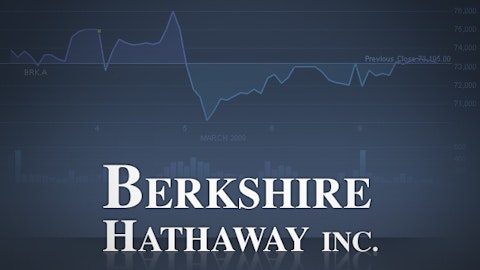Motley Fool analyst Matt Koppenheffer sits down with Rick Engdahl for a side-of-desk interview about banks. Are they really that hard to understand? Can the big banks be trusted? Join us for a discussion that sheds some light on banks from Citigroup Inc. (NYSE:C) to Wells Fargo & Co (NYSE:WFC), as well as some of the smaller players.
In this video segment, Matt discusses the factors affecting different types of banks, and why he thinks the time is ripe for investors to return to the sector.
A full transcript follows the video.
Rick Engdahl: I know downstairs on the first floor we have an asset management team who runs The Motley Fool funds. They had their annual shareholder meeting a few weeks ago, and I was there, listening to them.
They talked about how they have a basket of “baby banks” that they liked to invest in; their point being that there’s so much post-crisis… they weren’t sure about some of the bigger banks, but they felt very good about some of the smaller banks out there.
I just wanted to get your take on big banks versus baby banks, in your basket.
Matt Koppenheffer: I’m certainly not going to contradict. There are guys far smarter than me who are working on the asset management side.
Rick: As smart.
Matt: Yeah, I appreciate the flattery.
In my view, it’s not as much about big versus small, as it is about quality versus valuation. You can kind of find a good balance that leads to a good investment across a spectrum. When they’re talking about baby banks, I don’t know exactly how small they’re thinking.
Rick: Small regionals, I believe.
Matt: OK. Unfortunately, I don’t get a ton of time to look at … in the U.S. banking business I wouldn’t even say it’s like a pyramid. You’ve got the big four up here — Bank of America, JPMorgan, Citigroup Inc. (NYSE:C), and Wells Fargo & Co (NYSE:WFC) — and then you’ve got a group of super-regionals that are actually a good deal smaller, but still very, very large — U.S. Bancorp (NYSE:USB), BB&T Corporation (NYSE:BBT), SunTrust Banks, Inc. (NYSE:STI) is probably up there — those kind of banks.
Those are kind of a second tier, but then you’ve got a big, broad, giant group of much smaller banks. In terms of the U.S. versus global banking systems, we have a very broad, deep pool in terms of the number of banks that we have in this country.
If you look at Canada, if you look at a lot of the countries in Europe, it’s a very different banking system. It’s interesting that we’re so focused on the “too big to fail,” where when you look at a lot of other major economies, their banking system is basically just too big to fail, or close to just too big to fail.
Anyway, I think the same thing goes back to thinking about quality, thinking about management. I still think there are bargain prices out there for a lot of banks, but even if there aren’t bargain prices, if you find the right bank, if you find the right management team, it’s finding that fair price. Making sure you’re not over-paying.
I’m sure you can find that with baby banks, with smaller banks. Personally, I think right now you can find that throughout the spectrum of sizes.
The big four, I see those pretty much as a no-brainer right now in terms of where we are in the cycle for the economy, in terms of where those valuations are — because the valuations tend to cycle along with everything else.
One of the lazy bank investing rules is, you buy banks when, I think it’s under 1.5 times book value, or maybe it’s under 1.0 times book value. I would think about in that range, between 1.0 and 1.5 times book value. Then you sell when they’re 2.0 or 2.5 times book value.
When you look at the big banks, in terms of their book value multiples, with the exception of Wells Fargo & Co (NYSE:WFC), which is admittedly a cut above the other three, I think, they’re right in there. I think they’ll get back to those higher multiples, and in the meantime, the economy is going to continue to improve, their businesses are going to continue to improve, so I think you can do really well with the big banks. I think you can do well with some of the mid-tier banks, and I think you can find some great smaller banks.
I think in general, broadly speaking, it’s a sector that investors have been slow to come back to in the wake of the crisis. Understandably so, but I think it’s leaving a lot of opportunity for investors right now, while other sectors in the economy are getting bid up, and I just don’t think are nearly as attractive as the banking sector.
Rick: The big banks are going to be more susceptible to unpredictable global politics and economics. Is that correct to say?
Matt: Sure, some to a greater extent than the others.
One of the interesting things about the big banks is… as we’re talking, I’m grouping them together. People tend to group them together, but they’re very different businesses.
Wells Fargo & Co (NYSE:WFC), for example, is almost fully focused on the U.S. It is a U.S. bank and it serves U.S. clients and customers.
Citigroup Inc. (NYSE:C) is on the other end of the spectrum, geographically speaking. It’s got branches and it’s got locations and it’s got major business throughout the world. It’s almost more of a 50/50 split between what it’s doing in the U.S. versus the rest of the world. It might be even less of a 50/50 split, in favor of the rest of the world.
Then Bank of America, kind of in between those two; more U.S.-focused, but has a lot of global business, particularly through Merrill Lynch, but also through legacy Bank of America investment banking operations. JPMorgan, kind of the same thing, but focused more on growing its global business.
Citigroup Inc. (NYSE:C), definitely has itself lassoed to the rest of the world, particularly emerging markets. JPMorgan yes, a little bit less so. Bank of America, less so still, and then Wells Fargo & Co (NYSE:WFC) not really, so you’ve got a spectrum of how the global economy is going to impact the banks.
The article Big Banks vs. Baby Banks: Which Would You Buy? originally appeared on Fool.com and is written by Matt Koppenheffer.
Matt Koppenheffer has no position in any stocks mentioned. The Motley Fool recommends Wells Fargo. The Motley Fool owns shares of Citigroup and Wells Fargo.
Copyright © 1995 – 2013 The Motley Fool, LLC. All rights reserved. The Motley Fool has a disclosure policy.




